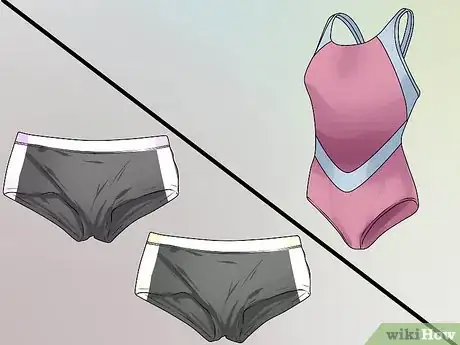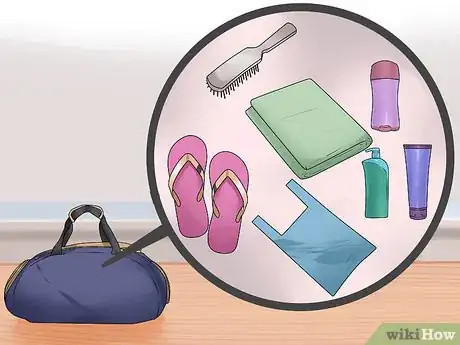This article was co-authored by Brad Hurvitz. Brad Hurvitz is a Certified Swimming Instructor for My Baby Swims, an adolescent swimming school based in La Jolla, California. Brad is trained as an Infant Swimming Resource (ISR) instructor with ISR's Self-Rescue® program. He specializes in training children aged six months to six years of age survival skills like floating on their back to breathe and swimming back to the wall, while also educating parents on how to better keep their kids safe. He has a Master of Business Administration from Oregon State University.
This article has been viewed 111,792 times.
Many middle school, high school, and college gym classes require a swimming unit, which involves spending substantial time with your peers in locker rooms, showers, and in and around a swimming pool. While many students dread this unit, and find that it makes them feel awkward and insecure, the swimming unit doesn’t need to be uncomfortable. If you plan ahead and bring things you need to class, and treat your peers and coach with respect, you’ll be well on your way to having a positive experience in your swimming unit.
Steps
Bringing the Right Supplies for the Pool
-
1Plan ahead for your day. Swim class is often inconvenient; it involves undressing, showering, getting wet, and then getting dressed again, all while you’re still at school and in front of your friends and peers. Plan ahead before you leave your home that morning, and you’ll be able to minimize the inconvenience that comes from swim class.
- If you have gym class earlier in the day, consider wearing your swimsuit under your clothes so you don’t have to change when you get to the locker room.
- If you’re a girl, consider tightly braiding your hair in the morning. No guarantees, but it may keep your hair dry.
- Avoid wearing tight clothes such as skinny jeans, since these are harder to put on after getting out of the pool.
- Always lock your belongings in a locker with a combination lock. Practice using the lock until you can confidently open it without looking at the code.
-
2Consider the swimwear that you plan on wearing. Your goal should be finding something that’s comfortable, practical, and efficient in the pool. You’ll need to wear the same swimwear for as long as your swimming unit lasts, so find something that you enjoy wearing.
- For girls, it is recommended that you choose a one-piece swimsuit that you feel comfortable in and that lets you move freely in the pool.
- For boys, you’ll need a pair of comfortable swim trunks. Avoid any that impair your movement or are excessively baggy.
- Consult your instructor and make sure that your planned attire follows any regulations in place.
Advertisement -
3Purchase a good pair of goggles. As long as your school allows them, goggles are a practical part of every swimmer’s attire. You should have a high-quality pair that will keep the water out of your eyes. This will help you focus more on your swimming, and less on the distracting feeling of water in your eyes.[1]
- When you wear your goggles, make sure that they’re not too tight across the nose.[2] Goggles should be snug around your eyes, and not let water seep in, but they shouldn’t be uncomfortably tight.
-
4Prepare your bag with necessities. When the gym period ends, you’ll probably need to dry off, shower, and change your clothes before you move on to the rest of your day. Plan ahead and bring everything you’ll need with you in your duffel bag. Include:
- Large plastic bag for your wet swimsuit.
- Shampoo and conditioner (for girls, or boys with longer hair).
- A hairbrush/wide toothed comb (for people with long hair).
- Body wash (Chlorine will dry out your skin unless you wash it off).
- Deodorant and/or body spray.
- Large beach towel.
- Makeup (if you plan to apply it after gym class).
- Flip-flops to wear on the pool deck.
-
5Bring tampons if you’re menstruating. If you’re on your period (or anticipate that you could be, within the next couple of days), bring tampons with you in your duffel bag. Tampons can be worn in the pool without any problem, and should be worn instead of pads in this setting.[3]
- The adhesive on most types of pads isn’t waterproof, so they may come off in the pool, and are generally less effective in water than tampons anyway.
- Many young women start wearing tampons (rather than pads) for the first time during a gym swimming unit. If you’re in this situation, it’s completely normal and nothing to feel worried or anxious about.
-
6Pack your things in a duffel bag. Since you’ll be changing clothes at the pool and bringing more items to class than you normally would, you’ll need a pool-specific bag to bring everything in. This is all in an effort to keep your belongings safe and intact.
- Make sure that the bag zips shut and has a flat bottom so your clothes won’t get wrinkled. In addition, you may want to look for a waterproof bag, in case pool water gets splashed on it.
- Consider investing in a combination lock if you haven’t already.
-
7Enjoy yourself! Usually, swimming units are stress-free and involve tons of free time. Don’t be too worried about it. Many people squirm at the thought of mandatory swimming with classmates, but end up loving it. Don’t get too worked up with anxiety over the swimming unit; be mature and have fun.
Preparing to Interact with Other Students
-
1Realize that everyone is as uncomfortable as you are. So often, it’s easy to imagine that your peers are enjoying the exact activities that make you feel uncomfortable or uneasy. It’s important to realize that everyone has the same concerns and insecurities about swim class.
- Use this to your advantage; if you know that others are uncomfortable as well, you don’t need to feel self-conscious or awkward. You’re not alone!
-
2Act naturally in the locker room. Many teens’ (even adults’) anxiety surrounding swimming in gym class stems from their apprehension about the locker room.[4] The main concern often stems from a lack of privacy, and from the awkward experience of being even partially undressed in front of your peers.
- Locker rooms showers are seldom a single large, open space. You can often find a private shower cell, in which you can shower, towel off, and change your clothes, if you’re uncomfortable changing in front of others.
- If there aren’t separate shower cells for you to change in, you can change your underwear with your towel still wrapped around your waist.
- Be discreet when undressing or showering around your peers. Don’t linger or stare at anyone’s body—this rule applies when your peers are wearing their swimsuits, too. Treat your peers with the same discretion that you’d like them to treat you with.
-
3Be kind towards the peers in your class. Many students feel anxious when faced with swimming; maybe they’re uncomfortable in water, don’t like the idea of changing and showering in front of their peers, or are concerned about being seen in revealing garments in front by members of the opposite sex. Rather than worsening this by being rude to people or treating anyone with scorn, be kind to your fellow students.
- Be considerate of your classmates. High-school especially is a time where many people are self-conscious, and standing around in tight, revealing clothing really doesn’t help.
- Don’t berate or belittle anyone.
-
4Enjoy the sense of community. Once everyone has gotten over the initial anxiety about being seen in a swimsuit and having to jump in a cold pool during the school day, swim class can be fun. It encourages a sense of community, and if you participate in the team-building, you can help yourself and other students enjoy the class more.[5]
- Be encouraging to your peers; cheer each other on in the pool.
- Say something like, “You’ve really come along way this month; you seem like you’re having fun in the water!”
Getting the Most Out of Your Swimming Unit
-
1Try your best in the pool. The point of any swimming unit is to learn how to swim (or to improve in your swimming skills), and you won’t get much out of the class if you don’t participate and make an effort.[6] Whether this is your first time in the pool or you’re an experienced swimmer, get out there, participate, and have fun!
- Even if you can’t swim, try your best. Most teachers can recognize when someone is trying and will give you a good grade for effort.
-
2Listen to the coach and follow their direction. High school swim unit is a great opportunity to improve your swimming skills, especially if you plan to compete in a swim club.[7] Your swim coach is most likely a highly qualified individual who cares about his or her students and wants to help them swim better.
- Even if you’re not a competitive swimmer and have no plans to become one, you should still obey the coach. He or she can lend a fun sense of community to the class, and swimming is a great way to stay in shape.
-
3Improve your competitive swimming abilities. Many high-school students are already involved in a swim team, and regularly compete in swimming or diving competitions. Learning from a coach is especially valuable if you’re already a competitive swimmer. Even if you routinely swim and train at a private swimming club, your high school coach can add a sense of community and team spirit to your swimming.[8]
- Focus on learning new strokes and improving your time; tune out distractions. Take your training—even if it’s not at your normal swim club—as seriously as possible.
Community Q&A
-
QuestionWhat if I don't know how to swim?
 Community AnswerThe pool should have a shallow end. Also, you should tell the teacher and ask him/her if they can help teach you.
Community AnswerThe pool should have a shallow end. Also, you should tell the teacher and ask him/her if they can help teach you. -
QuestionHow do I prepare for swimming if I discover my new suit is too small on the day of the class?
 Community AnswerI would suggest informing your teacher that your suit is too small and you feel uncomfortable wearing it in front of other students. She may have another one you could use, or she may allow you to sit out until the next class.
Community AnswerI would suggest informing your teacher that your suit is too small and you feel uncomfortable wearing it in front of other students. She may have another one you could use, or she may allow you to sit out until the next class. -
QuestionDo I bring extra undeewear
 Community AnswerNot necessarily; you should be able to put back on the underwear that you were wearing when you arrived. If you'd prefer a clean pair, though, it's fine to bring an extra pair.
Community AnswerNot necessarily; you should be able to put back on the underwear that you were wearing when you arrived. If you'd prefer a clean pair, though, it's fine to bring an extra pair.
References
- ↑ Brad Hurvitz. Certified Swimming Instructor. Expert Interview. 13 February 2020.
- ↑ http://www.oprah.com/health/Advice-for-Nervous-Swimmers-How-to-Swim-if-You-Havent-in-a-While
- ↑ https://www.ubykotex.com/en-us/periods/period-advice/everything-you-need-to-know-about-swimming-on-your-period
- ↑ https://www.womenshealth.northwestern.edu/blog/locker-room-anxiety
- ↑ https://swimswam.com/4-reasons-high-school-swimming-awesome/
- ↑ https://swimswam.com/4-reasons-high-school-swimming-awesome/
- ↑ https://swimswam.com/4-reasons-high-school-swimming-awesome/
- ↑ https://swimswam.com/4-reasons-high-school-swimming-awesome/
About This Article
To prepare for the swimming unit in gym class, choose swimwear that is comfortable and practical, as you’ll be wearing it for the duration of the unit. When you’re packing your bag, pick necessities that you’ll need during the unit and for the rest of the day, such as deodorant, a hairbrush, and a plastic bag for your swimwear. If you’re uncomfortable changing in front of others, try to find a private shower cell or change your underwear with a towel around your waist. Finally, remember that your peers are just as uncomfortable as you are, so don’t linger or stare at anyone’s body. For more advice, like how to encourage your peers in the pool, read on!







































































